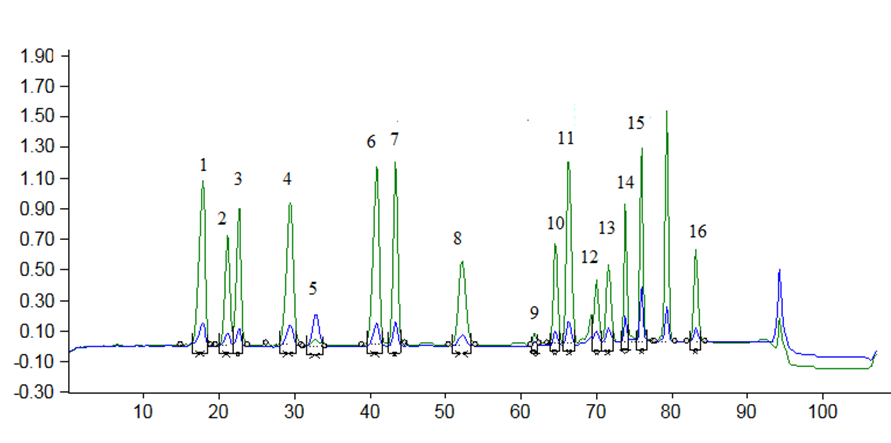THE STUDY OF AMINO ACID CONTENT OF GLYCYRRHIZA GLABRA OVERGROUND AND UNDERGROUND PARTS
UDC 615.322:547.466
Abstract
The purpose of the research was a comparative study of the amino acid composition and the quantitative content of individual amino acids in the over-ground and underground parts of Glycyrrhiza glabra L. (Fabaceae) growing in the Volgograd region. Previously, using the reaction with ninhydrin, as well as carrying out TLC on the plates «Silufol», the presence of amino acids in watery extracts from the samples of vegetable raw materials was established. On an AAA 400 amino acid analyzer in the underground and over-ground parts of Glycyrrhiza glabra L. 16 amino acids were identified, 9 of which are interchangeable and 7 are irreplaceable, their quantitative content and accumulation characteristics were established. The total amount of amino acids found in the over-ground parts of the medicinal plant is higher (15.88%) than in the underground organs – 8.42%. Of the individual amino acids, glutamic acid (1.84±0.02%), aspartic acid (1.74±0.02%), arginine (1.03±0.01%), leucine (1.41±0.01%), lysine (1.02±0.01), valine (0.92±0.01%), phenylalanine (0.86±0.01%), isoleucine (0.76±0.01%), threonine (0.77±0.01%) was detected. In the underground organs of the studied plant, aspartic (1.17±0.02%) and glutamic (0.62±0.01%) acids predominantly accumulate, but in percentage they are 1.5–3 times less than the over-ground parts. Separately, it should be noted a feature of the accumulation of proline, which is one of the dominant amino acids in the over-ground and underground parts of Glycyrrhiza glabra L. (1.49±0.02% and 1.87±0.02%, respectively). Obtained in the course of the research data indicate the prospects for further study of the over-ground parts of the medicinal as a source of this group of biologically active substances.
Downloads
Metrics
References
Tolstikov G.A. et al Solodka: bioraznoobraziye, khimiya, primeneniye v meditsine. [Licorice: biodiversity, chemistry, medical applications]. Novosibirsk, 2006, 311 p. (in Russ.).
Yanitskaya A.V., Zemlyanskaya I.V., Nedil'ko O.V. Vestnik Voronezhskogo gosudarstvennogo universiteta. Seriya: Khimiya. Biologiya. Farmatsiya, 2015, no. 3, pp. 103–106 (in Russ.).
Farag M.A., Porzel A., Wessjohann L.A. Phytochemistry, 2012, vol. 76, pp 60–72.
Yegorov M.V., Kurkin V.A. Sovremennyye problemy nauki i obrazovaniya, 2015, no. 6, pp. 553 (in Russ.).
Yanitskaya A.V., Kurkin V.A., Nedil'ko O.V., Samoylova I.N., Shcherbinin A.S., Yegorov M.V. Vestnik Volgograd-skogo gosudarstvennogo meditsinskogo universiteta, 2015, no. 4(56), pp. 116–118 (in Russ.).
Rastitel'nyye resursy Rossii. Dikorastushchiye tsvetkovyye rasteniya, ikh komponentnyy sostav i biologicheskaya ak-tivnost'. Semeystva Fabaceae – Apiaceae. [Plant resources of Russia. Wild flowering plants, their component composi-tion and biological activity. Families Fabaceae - Apiaceae]. St. Petersburg, Moscow, 2010, vol. 3, 601 p. (in Russ.).
Mayevskiy P.F. Flora sredney polosy yevropeyskoy chasti Rossii. [Flora of the middle zone of the European part of Russia]. Moscow, 2006, 514 p. (in Russ.).
Lysikov Yu.A. Eksperimental'naya i klinicheskaya gastroenterologiya, 2012, no. 2, pp. 88–105 (in Russ.).
Fursa N.S., Trzhetsinskiy S.D., Mozul' V.I., Isakhanov A.L., Kolosova O.A., Chikina I.V. Vestnik Voronezhskogo gosudarstvennogo universiteta. Seriya: Khimiya. Biologiya. Farmatsiya, 2016, no. 2, pp. 152–156 (in Russ.).
Yatsyuk V.Ya., Yeletskaya O.A. Rossiyskiy mediko-biologicheskiy vestnik imeni akademika I.P. Pavlova, 2009, no. 3, pp. 146–150 (in Russ.).
Bondarevich Ye.A. Khimiya rastitel'nogo syr'ya, 2018, no. 3, pp. 83–89 (in Russ.).
Tokhsyrova Z.M., Nikitina A.S., Popova O.I. Fundamental'nyye issledovaniya, 2015, no. 2–15, pp. 3330–3332 (in Russ.).
Drozdova I.L., Minakova Ye.I. Sorbtsionnyye i khromatograficheskiye protsessy, 2018, vol. 18, no. 1, pp. 52–57 (in Russ.).
Kruglaya A.A. Farmatsiya i farmakologiya, 2016, vol. 4, no. 6, pp. 33–43 (in Russ.).
Selina I.I. Fundamental'nyye issledovaniya, 2014, no. 3–4, pp. 770–774 (in Russ.).
Nurtayeva Zh.T. et al Novosti nauki Kazakhstana, 2015, no. 1(123), pp. 88–98 (in Russ.).
Abdrakhmanova G.M., Zhaugasheva S.K., Pavelkovskaya G.P. Farmatsiya i farmakologiya, 2014, vol. 2, no. 6(7), pp. 36–37 (in Russ.).
Khabibrakhmanova V.R. et al Khimiya rastitel'nogo syr'ya, 2016, no. 2, pp. 97–102 (in Russ.).
Simonyan A.V., Salamatov A.A., Pokrovskaya Yu.S., Avanesyan A.A. Ispol'zovaniye ningidrinovoy reaktsii dlya kolichestvennogo opredeleniya a-aminokislot v razlichnykh ob"yektakh. [The use of ninhydrin reaction for the quantita-tive determination of α-amino acids in various objects]. Volgograd, 2007, 106 p. (in Russ.).
GOST 32195-2013. Korma, kombikorma. Metod opredeleniya soderzhaniya aminokislot. [GOST 32195-2013. Feed, feed. Method for determination of amino acid content]. Moscow, 2015, 27 p. (in Russ.).

Copyright (c) 2020 Khimiya Rastitel'nogo Syr'ya (Chemistry of plant raw material)

This work is licensed under a Creative Commons Attribution 4.0 International License.

This work is licensed under a Creative Commons Attribution 4.0 International License.
The authors, which are published in this journal, agree to the following conditions:
1. Authors retain the copyright to the work and transfer to the journal the right of the first publication along with the work, at the same time licensing it under the terms of the Creative Commons Attribution License, which allows others to distribute this work with the obligatory indication of the authorship of this work and a link to the original publication in this journal .
2. The authors retain the right to enter into separate, additional contractual agreements for the non-exclusive distribution of the version of the work published by this journal (for example, to place it in the university depository or to publish it in a book), with reference to the original publication in this journal.
3. Authors are allowed to post their work on the Internet (for example, in a university repository or on their personal website) before and during the review process of this journal, as this may lead to a productive discussion, as well as more links to this published work.











